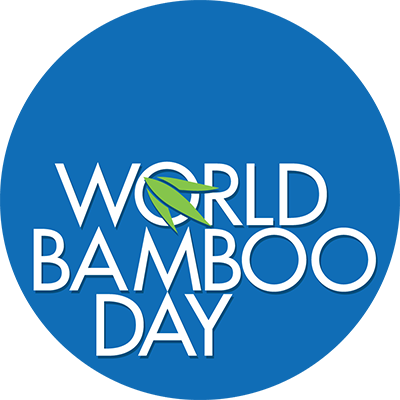From bikes to bedding to bridges, bamboo has been used to make more things than you could imagine. So, in celebration of World Bamboo Day, we’ve collected our favorite quirky, interesting, and funny facts about bamboo. Read on and be amazed by the wild world of bamboo!
On September 18th, bamboo lovers around the world celebrate World Bamboo Day. Bamboo has quickly become the poster child for sustainable materials, and for good reason. Beyond its eco-friendly growth cycle, the plant is an extremely versatile material. As you’ll soon find out, the list of things that can’t be made with bamboo might be shorter than the list of what can be made!

18 Facts About Bamboo You’d Never Guess

1. Bamboo itself is a common ingredient in many dishes
You might not usually put bamboo on your grocery list. But bamboo shoots are a common ingredient in many Asian dishes. Alas, don’t go cooking up your favorite bamboo plant just yet! Not all bamboo is edible, and only bamboo shoots (the tiny first sprouts of a bamboo plant) have the tender texture that many enjoy. The season for harvesting bamboo shoots is quite short and only lasts 3-4 weeks each spring. If they’re not harvested early enough, bamboo shoots take on a bitter taste.

2. The first lightbulb filament was made of bamboo
There’s a little-known fact that ties Thomas Edison to the people of Yawata City, Japan. Light! As Thomas Edison worked to find a filament that was heat resistant enough to allow a lightbulb to burn for many hours, he stumbled upon bamboo. Compared to cotton and other materials he tested, carbonized bamboo lasted for hundreds of hours more. The rest is history, but bamboo’s vital role is still celebrated yearly in Japan. After Edisons’ death, a memorial was built in Yawata City, where the bamboo used by Edison was grown. Now, on the anniversary of Edisons’ birthday, a light festival is held at the memorial space.
3. A grove of bamboo produces 35% more oxygen than a similar stand of trees
The bamboo plant is extremely efficient at improving air quality, absorbing carbon dioxide, and of course, releasing the oxygen we need to breathe easily. Compared to other plants, bamboo produces a significantly greater amount of oxygen. This fact contributes to its status as one of the most eco-friendly materials on the planet!

4. Bamboo is perfectly shaped for use as a musical instrument
Because of its naturally hollow internal structure, bamboo is well-suited to be used as a flute and other wind instruments. You’ll also find bamboo used to make guitars and ukuleles. Bamboo instruments are widely used around the world, and in some religions, even the gods are believed to use them.

5. Bamboo has been used to construct bridges, fences, and houses since the 10th century
Stronger than steel, readily available, and lightweight. Bamboo is the perfect material for building! From simple huts to sturdy bridges (and even the scaffolding itself), bamboo is a common building material throughout Asia. Now, bamboo is becoming a more common material for flooring and furniture worldwide. Want to try out a night or two in a bamboo house? Check out these dreamy destinations in Bali…

6. Bamboo is the fastest growing plant on the Earth and can be harvested every 3-5 years
Yet another reason that bamboo is prized for its sustainability! While bamboo can be used for the same applications as wood, it’s actually a woody type of grass. Because of this, bamboo grows extremely fast. It can be harvested much more frequently than the 10-20 years it takes for hardwood to be ready for harvest.
7. Giant Pandas spend up to 16 hours a day eating bamboo
Making up over 98% of their diet, bamboo foraging takes up the majority of a Giant Pandas life. In fact, over time, both Giant Pandas and Red Pandas have developed a “sixth finger” that helps them grip bamboo more easily.
*Not to worry - the bamboo that Pandas eat is an entirely different species than the bamboo we use to create our bamboo utensils and other products.
8. Bamboo is naturally antibacterial and antifungal
Bamboo has a natural barricade that repels bacteria and insects. This makes it easy for bamboo to thrive without the use of pesticides. And, it makes bamboo a healthier material that resists odors and discoloration caused by bacteria.

9. Bamboo is used to make many textiles and is more energy-efficient than organic cotton
The bamboo plant can be broken down and spun into fine fibers for bedding, clothing, and towels. Bamboo fabric is ultra-soft, absorbent, and it takes about ⅓ of the water needed to grow the same amount of organic cotton.

10. People have made cars and bicycles out of bamboo
Of all the facts about bamboo, this one will give you a glimpse into the future of sustainable travel. Bamboo has been used in designs for cars and bicycles for years. Now it’s taking the stage for developing cars that are biodegradable and low-waste. Don’t believe us? Check out this prototype of the Phoenix Bamboo Car.

11. The first and only certified organic cooking utensils are made out of bamboo
Many people focus on eating organic foods that are safe for them and their families. But the cookware you use is just as important! The first certified organic utensils are made from 100% organic bamboo and finished with organic linseed oil.
12. Bamboo is the ultimate regenerative plant: It can be harvested without damaging the roots
This is one of our favorite facts about bamboo! Rather than uproot the whole plant, bamboo is harvested by cutting the plant near the bottom. And, unlike trees, the bamboo plant will simply continue to grow right where it left off. This allows for less time and resource use- and keeps the soil free from excessive tilling.
13. The roots of bamboo are excellent at preventing soil erosion
Because bamboo has extensive root networks, bamboo forests work to keep soil compact and prevent erosion. During extreme weather events like typhoons and floods, bamboo can even help prevent landslides.
14. There are over 1,600 species of bamboo around the world
From giant bamboo that can be up to 100 feet tall to Chinese fountain bamboo that’s heavy with shade-producing foliage, bamboo comes in many shapes and sizes. But the type of “bamboo” you’re probably most familiar with- lucky bamboo-isn’t actually bamboo. Although this mini-version looks strikingly similar, lucky bamboo’s real name is Dracaena Sanderiana.

15. Bamboo is used to make sustainable alternatives to disposable plates and cutlery
Gone are the days where disposable plates were only found coated in plastic and unrecyclable. At bambu, thin sheets of bamboo veneer are now used to make biodegradable plates and cutlery.
16. Bamboo only flowers or seeds every 100 years. When it does, all other plants of the species (no matter where are) do it too
It’s exceedingly rare to see bamboo flower. In fact, it only happens every 50-150 years. But when it does, every plant that is of the same species (even if it’s on the other side of the world), will burst into flower at the same time.

17. Bamboo is lighter than titanium, which makes it a great material for outdoor cooking and eating utensils
Bamboo is one of the lightest materials you can use to make utensils. For backpackers and other outdoor enthusiasts, this makes for an ideal utensil for eating and cooking in remote places.
18. Bamboo is very drought resistant. To save water during dry spells, bamboo leaves will curl up or drop off to save resources
The bamboo plant is incredibly resistant and hardy and grows on every continent except for Antarctica. To survive with little to no water, the bamboo plant will curl in its leaves to preserve resources for the heart of the plant. Then, if the drought becomes more extreme, its leaves will drop off to save even more water for essential functions.
Did we miss any facts about bamboo that you love? Help us celebrate world bamboo day by commenting your favorite bamboo fact below!
Want to know even more about bamboo? Learn just how long bamboo utensils last (hint: it’s much longer than you think).





